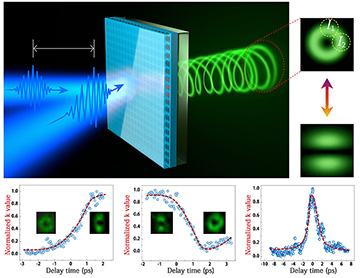 Top: Two laser beams with spatial and temporal separation pump the sample. Bottom: The transition from a donut beam profile to two lobes (left), from two lobes to a donut (center), and a complete process from donut to two lobes and back to a donut (right). [Enlarge figure]
Top: Two laser beams with spatial and temporal separation pump the sample. Bottom: The transition from a donut beam profile to two lobes (left), from two lobes to a donut (center), and a complete process from donut to two lobes and back to a donut (right). [Enlarge figure]
All-optical switching, which underpins modern optical communications and information processing, faces new requirements for next-generation optical and quantum computing. These emerging technologies put a premium on low energy consumption, high speed, strong modulation ratios and high-density integration. Traditionally, ultrafast all-optical switching has relied on a nonlinear response in optical materials. Those tiny effects commonly require an additional resonator to enhance the light–matter interaction and reduce the energy consumption.
Yet the resonance lifetime, which is proportional to Q⁄ω, affects the ringdown time and restricts the response time. That poses a severe challenge for all-optical switch design, and a trade-off between ultra-low energy consumption and ultrafast response. One potential solution lies in plasmonic nanocavities with low quality (Q) factors and ultra-small effective mode volumes.1 Unfortunately, metal’s intrinsic absorption means that plasmonic switches experience huge coupling and propagating losses, exceeding 19 dB.
Recently, we have demonstrated an alternative approach to all-optical switching that can break this long-standing challenge—an approach based on the physics of topologically protected optical bound states in the continuum (BICs).2 The remarkably large Q factors offered by BICs can facilitate an enormous response in a photonic structure to incident electromagnetic waves, and thus strong near-field enhancement.3,4 In addition, the symmetry-protected BIC is extremely sensitive to the local symmetry perturbations.5 This means that, by considering the correspondence between the external excitation and optical gain, one can use the pump profile to control the far-field laser profile at the topologically protected BICs.
For a square periodic lattice, the topologically protected BIC laser appears at the Г-point.3 When the system is pumped with a circular beam, the gain area preserves the fourfold symmetry and produces a BIC laser with donut beam profile. Once the gain region degrades to twofold symmetry, the output quickly switches to two lobes. The corresponding time-resolved experiment shows that the transition process takes place in 1 to 1.5 ps, orders of magnitude faster than the lifetime of the corresponding microlaser.
This ultrafast control is attributed to previously ignored far-field characteristics of BICs. The far-field beam profile of the BIC microlaser is determined by the destructive interference at the radiation channel. Therefore, the transition process in the far-field profile merely requires a re-distribution of laser emission, instead of requiring that the laser mode be switched on and off.
Our work demonstrates that the switching time can be independent of the resonance lifetime. By further utilizing the ultrahigh Q factors of BICs, the laser threshold can be dramatically reduced as well. Consequently, the trade-off between ultralow energy consumption and ultrafast response can eventually be broken. We believe that this new switching mechanism could have a significant impact on optical and quantum computing.
Researchers
Shumin Xiao and Qinghai Song, Harbin Institute of Technology, Shenzhen, China
Yuri Kivshar, Australian National University, Canberra, Australia
References
1. M. Ono et al. Nat. Photon. 14, 37 (2020).
2. C. Huang et al. Science 367, 1018 (2020).
3. C.W. Hsu et al. Nat. Rev. Mater. 1, 16048 (2016).
4. K. Koshelev et al. Opt. Photon. News 31(1), 38 (January 2020).
5. B. Zhen et al. Phys. Rev. Lett. 113, 257401 (2014).
